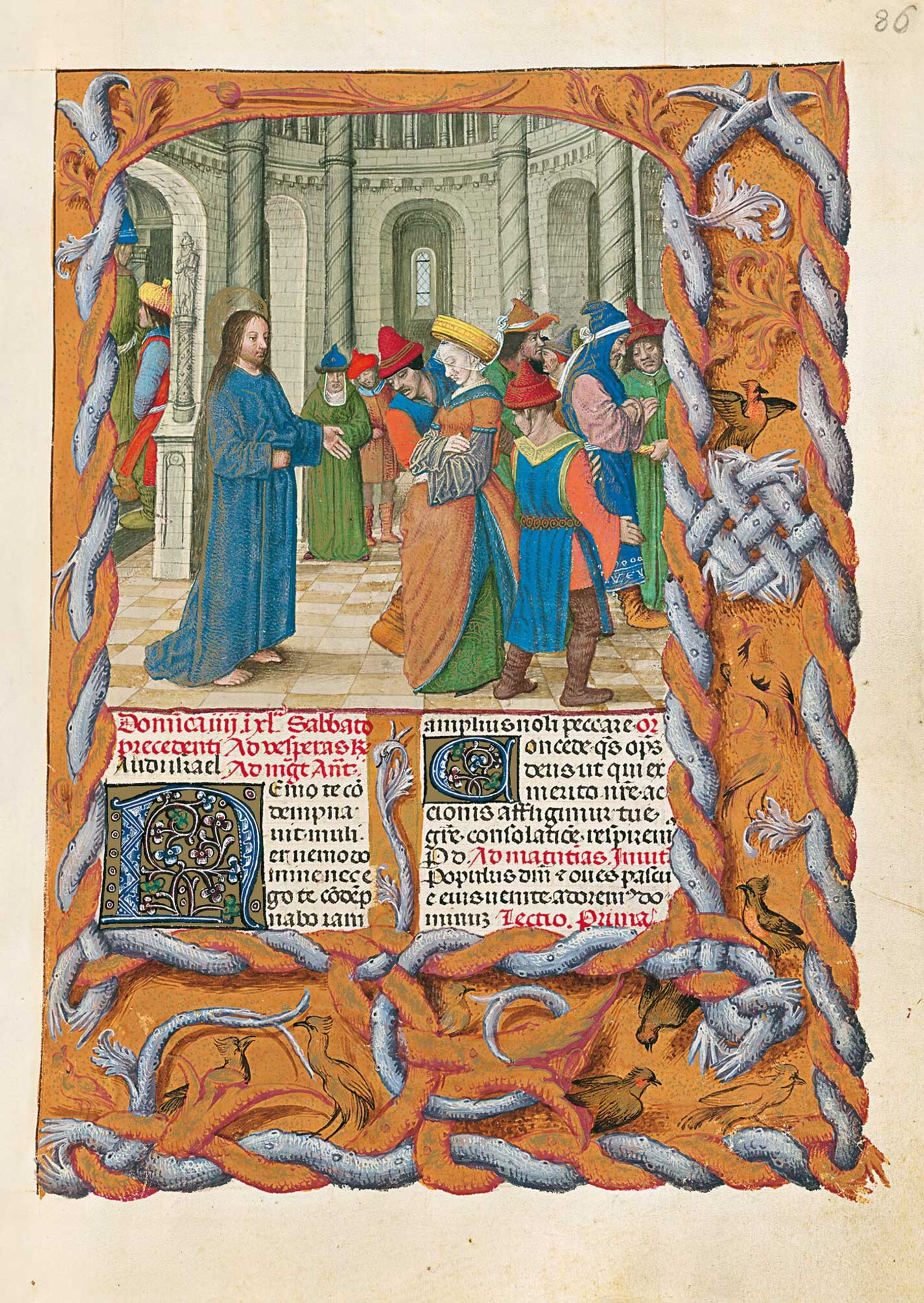A twenty-four line framed miniature over both columns of text of Christ asking the Woman taken in Adultery “Hath no man condemned thee” (Jn 8 vv. 1-11), which is the Gospel for the preceding Saturday in the Dominican Missal, and Christ’s very words are referred to in the antiphon to Magnificat for First Vespers of this Sunday, Nemo te condempnavit. Although normally the subject of the picture is taken from the Sunday Gospel, this very famous story, read on the Saturday, was evidently chosen in preference. The scene is set in the Temple and the scribes and Pharisees who had brought the woman to Jesus are present: And said to him: Master, this woman was even now taken in adultery. Now Moses in the law has commanded us to stone such a one. But what sayest thou? And this they said tempting him, that they might accuse him. But Jesus bowing himself down, wrote with his finger on the ground. When therefore they continued asking him, he lifted up himself and said to them: He that is without sin among you, let him first cast a stone at her. And again stooping down, he wrote on the ground. But they hearing this, went out one by one, beginning at the eldest. And Jesus alone remained, and the woman in the midst. Then Jesus lifting up himself, said to her: Woman, where are they that accused thee? Hath no man condemned thee? Who said: No man, Lord. And Jesus said: Neither will I condemn thee. Go and now sin no more. The artist illustrates the moment just before Jesus’s final words to the woman, as the Scribes and Pharisees go out “one by one”. There is a full border of the first category with intertwining branches in gold and silver-grey with birds on a dull yellow ground stippled with gold.

A twenty-four line framed miniature over both columns of text of Christ asking the Woman taken in Adultery “Hath no man condemned thee” (Jn 8 vv. 1-11), which is the Gospel for the preceding Saturday in the Dominican Missal, and Christ’s very words are referred to in the antiphon to Magnificat for First Vespers of this Sunday, Nemo te condempnavit. Although normally the subject of the picture is taken from the Sunday Gospel, this very famous story, read on the Saturday, was evidently chosen in preference. The scene is set in the Temple and the scribes and Pharisees who had brought the woman to Jesus are present: And said to him: Master, this woman was even now taken in adultery. Now Moses in the law has commanded us to stone such a one. But what sayest thou? And this they said tempting him, that they might accuse him. But Jesus bowing himself down, wrote with his finger on the ground. When therefore they continued asking him, he lifted up himself and said to them: He that is without sin among you, let him first cast a stone at her. And again stooping down, he wrote on the ground. But they hearing this, went out one by one, beginning at the eldest. And Jesus alone remained, and the woman in the midst. Then Jesus lifting up himself, said to her: Woman, where are they that accused thee? Hath no man condemned thee? Who said: No man, Lord. And Jesus said: Neither will I condemn thee. Go and now sin no more. The artist illustrates the moment just before Jesus’s final words to the woman, as the Scribes and Pharisees go out “one by one”. There is a full border of the first category with intertwining branches in gold and silver-grey with birds on a dull yellow ground stippled with gold.